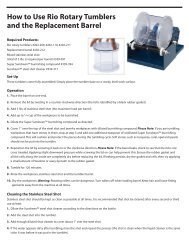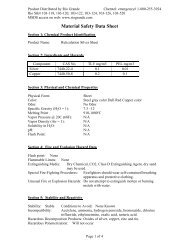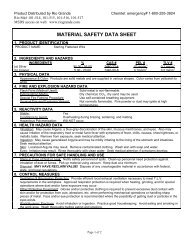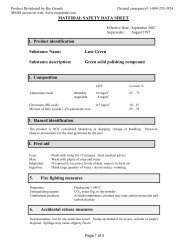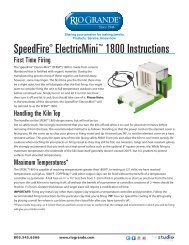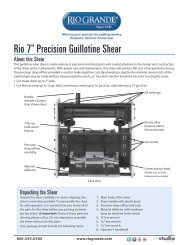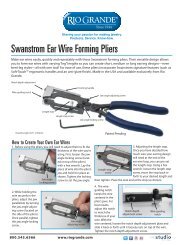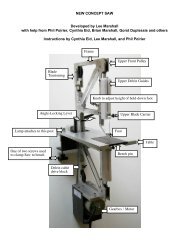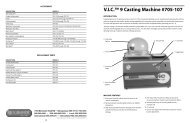Now More Than Ever - Rio Grande
Now More Than Ever - Rio Grande
Now More Than Ever - Rio Grande
You also want an ePaper? Increase the reach of your titles
YUMPU automatically turns print PDFs into web optimized ePapers that Google loves.
journal of the pmc guild<br />
fusion<br />
The Journal of the International PMC Guild<br />
PROFESSIONAL DEVELOPMENT<br />
<strong>Now</strong> <strong>More</strong> <strong>Than</strong> <strong>Ever</strong><br />
Photo by Dennis Griggs, Courtesy of Haystack Mountain School of Crafts<br />
9<br />
Don’t let the lousy economy fool you. Artisans are mindful<br />
of their money, and many are adjusting what they spend<br />
on professional development accordingly. But as they find<br />
ways to save, they are doing their best to not allow a sour<br />
economic outlook get in the way of improving their skills<br />
and becoming better artists.<br />
2009 /3
fusion nine<br />
page 2<br />
To become more efficient, members of the PMC Guild are taking<br />
online classes instead of traveling to workshops. They’re experimenting<br />
with dust, filings and shavings of PMC, learning to reconstitute the material<br />
for future use. Some are selling off surplus art supplies and scraps of<br />
silver so they can stockpile PMC to guard against price increases. Many are<br />
looking long and hard at the shows they attend to ensure they’re spending<br />
wisely. Some economize by sharing booths to reduce their fees.<br />
Others are using this time to develop different art-related skills that<br />
might lead to income, so they can keep learning and creating. One woman<br />
said she is writing more freelance articles for magazine and other publications.<br />
When she gets a check, she buys silver. Another said she is spending<br />
more time in the studio to put to use the skills she has already acquired.<br />
But the bottom line for everyone we talked to is this: They cannot<br />
afford to stop enhancing their skills, and will find ways to justify the<br />
expense of professional development, whether it is attending workshops,<br />
networking with colleagues via the Internet or spending more time in<br />
bookstores and libraries. Indeed, because of the economy, it may be more<br />
important than ever to focus on skill development so they will be better<br />
positioned to stand out in a crowded field when the economy improves.<br />
“When a workshop is being offered in a specific skill or technique I<br />
need and I am available, I sign up,” said Linda Kaye-Moses, a jeweler from<br />
Massachusetts. “This does not vary with the economy, because no matter<br />
what the financial state of the country is, I still need to learn those techniques<br />
that will allow me to make the work I want to make.”<br />
Melanie Miller, an artist from Georgia, agreed. “It’s a necessity for me.<br />
It’s not a hobby or a desire. If it’s worth it, I will make way for it somehow<br />
in my budget, because it will increase my income if I become better at<br />
what I do,” she said.<br />
Kelly Russell of Maryland is taking fewer classes than in the past.<br />
“When things were really good, I would take three or four classes a year<br />
and absorb the costs into my professional budget. If I have a good year<br />
and go to a lot of shows, there are a lot more classes to take. This year, I<br />
probably won’t take any classes,” she said.<br />
That does not mean Russell will stop learning. She is buying more<br />
books and making better use of other learning tools, redirecting her resources<br />
to lower cost self-improvement tools. “I read a ton, and I use the<br />
Internet,” she said.<br />
Jocelyn Cooley of Arizona began working with PMC three years<br />
ago, and “sucked up everything I could” in terms of workshops and<br />
conferences, spending several thousand dollars in a short amount of time.<br />
Confident in her skills and eager to put them to good use, lately she has<br />
focused her attention on her craft, spending as much time as she can in<br />
her studio.
journal of the pmc guild<br />
PMCguild<br />
International<br />
The PMC Guild is a<br />
members organization with<br />
the mission of providing<br />
support, education, and<br />
exposure for artists working<br />
in Precious Metal Clay.<br />
PMC Guild<br />
1921 Cliffview Lane<br />
Florence, KY 41042<br />
Executive Director<br />
Jeanette Landenwitch<br />
Director@PMCguild.com<br />
Treasurer<br />
Darnall Burks<br />
Treasurer@PMCguild.com<br />
Communications<br />
Tim McCreight<br />
Tech@PMCguild.com<br />
Journal Editor<br />
Bob Keyes<br />
Journal@PMCguild.com<br />
Web Manager<br />
Sadelle Wiltshire<br />
Web@PMCguild.com<br />
To Join, Renew, or<br />
Edit Info Online<br />
www.PMCguild.com<br />
Membership Questions<br />
(toll-free)<br />
866–315–6487<br />
Speak with the Director<br />
859–586–0595<br />
“For a good year and a half, I busted it out and<br />
did all the hands-on training I could. I was going to<br />
everything I could manage, always seeking out the<br />
best teachers,” she said.<br />
These days, she is content to learn by reading,<br />
and is discriminating in the workshops and conferences<br />
she attends. The only professional development<br />
she has in her plans are next year’s PMC Conference<br />
at Purdue and a preconference workshop.<br />
Miller dedicates most of her professional development<br />
budget to attending fairs and festivals,<br />
where she sells her work. While those events may<br />
not qualify as professional development in the strict<br />
sense of the phrase, Miller points out that the fairs<br />
allow her to meet people, exchanges ideas, and get<br />
feedback on her work from a diverse public.<br />
She attends as many as 20 a year, and does not<br />
plan to alter her routine in 2009. Each show has a<br />
booth fee that ranges from $95 to $650, Miller said.<br />
“But that’s how I sell my work. At some of these big<br />
shows where people come in hordes and come to<br />
buy, it’s worth it.”<br />
Because she stays busy year-round traveling to<br />
shows, Miller generally does not attend workshops<br />
or conferences. She does buy DVDs and books and<br />
also has taken courses over the Internet. This winter<br />
she took an online class about riveting taught by<br />
Robert Dancik.<br />
page 3
fusion nine<br />
Kaye-Moses invests in books. She learns from them and finds inspiration<br />
within the pages. She also reviews books and needs to know what’s<br />
out there and how it’s being presented. She subscribes to many magazines<br />
and journals and does not plan to let her subscriptions lapse. “This will<br />
remain constant,” she said emphatically.<br />
She does not plan to attend a conference this year, but that is more<br />
a matter of conflicting commitments than the economy. “My attendance<br />
at conferences is essential to my ongoing life as a teaching, writing, and<br />
working artist,” she said.<br />
If there is a noteworthy change in her budget, Kaye-Moses said it has<br />
to do with factors that are not only related to the larger economic picture.<br />
For instance, for 20 years she has spent a certain amount of money on<br />
stones each year. This year, she does not plan to spend as much as previously.<br />
“One reason is that I don’t need any more specialty stones at this<br />
stage in my life, and another is that the economy has slowed down considerably.<br />
As shows progress throughout the year, I may see a change, but<br />
right now I’m limiting what I spend on stones.”<br />
For Russell, her big commitment in 2009 is the Bead and Button show<br />
in Milwaukee, scheduled for late May and early June. In the past, she has<br />
taken classes associated with the show. This year, she will show her work,<br />
but not enroll in classes. She has greatly reduced the number of shows she<br />
plans to attend, and is taking a wait-and-see approach to the economy.<br />
“Two years ago, I did 13 shows in eight months. Last year, I did five.<br />
This year, it will be two, maybe three. And I am sharing a booth to cut<br />
my costs in half,” she said. Her hope is that people who attend the show<br />
will continue to buy her work. If they do, she will use that money to take<br />
classes, but until she has the money in hand, she cannot justify the enrollment<br />
fees and travel costs associated with the classes. “I’m just trying to<br />
hang on so people will remember me when the things improve again.”<br />
Cooley said her decision to cut back on classes and workshops has less<br />
to do with the economy and more to do with her place in life these days.<br />
As an artist, she feels she is at a crossroads. She is ready for the next step<br />
in her career, which may be a larger presence on the Web or gallery representation.<br />
She is using this time to take stock and create work.<br />
“It became apparent that it was time for me to go into the studio<br />
and start making my own thing happen. I noticed that I would go to a<br />
workshop and kind of feel like I’d rather be off playing instead of sitting in<br />
a class. I think I know how to handle my medium now.<br />
“I can’t imagine not taking classes again someday—it just feeds me. I<br />
just feel that right now, I need to be doing my work.”<br />
page 4
journal of the pmc guild<br />
CREATIVITY<br />
Bob Keyes<br />
We’re all familiar with the helpless feeling. We sit at our bench, fiddling<br />
with tools; our minds turn over ideas, but nothing sticks and the ideas<br />
fade away. Creativity can be fleeting. One minute it’s there and you feel<br />
like you’re on an endless roll. But then it’s gone and no matter how hard<br />
you try, you can’t seem to find the spark that ignites the next body of<br />
work, perhaps unable even to work variations on a piece that you’ve made<br />
before.<br />
It’s called a creativity block, and it happens to the best of us, professionals<br />
and amateurs alike. The question is, how do you move the block or<br />
effectively navigate around it? Are there devices, or tricks, that are useful<br />
in getting back to being productive? That’s a loaded question, because<br />
there is no right or single answer. The answer is different for each individual<br />
artist. Some people, when they run up against a block, sit and stare<br />
at the studio walls until they figure it out. Others might go for a walk.<br />
We put the question to a group of five artists who gathered in mid-<br />
March in Portland, Maine. These five women, all friends, came together<br />
in at one friend’s studio for three days to exchange ideas, engage in<br />
conversation and work alongside each other. Their goal was not necessarily<br />
to create, and in fact none of the women expressed a goal of leaving<br />
with finished work. Instead, they were simply seeking a shared experience<br />
outside their comfort zone in an attempt to freshen their perspective and<br />
broaden their creative vocabulary.<br />
All the women have taken workshops in PMC and are familiar with<br />
the clay, but this gathering had nothing to do with metal clay. Instead,<br />
they came together to experiment with encaustics, or hot wax painting, a<br />
medium they were all familiar with, but knew little about. Their material of<br />
choice was less important than the lessons and advice they shared about<br />
creativity and visual thinking. For them, the gathering was an effort to<br />
grow and evolve as artists and individuals, giving each person another tool<br />
to use when confronted with a block.<br />
“There’s almost always a good reason why you are blocked,” said<br />
Nancy Moore Bess, a basketmaker from Massachusetts. “It could be stress<br />
at home or at work. It could be health issues, or a distraction of some kind.<br />
They’re all very good reasons.”<br />
“You have to have a talk with yourself,” added Lissa Hunter, who<br />
hosted the gathering. “What is it? It might be that you just did a big body<br />
of work and you have what I call ‘post-artem depression.’ You spent it all,<br />
and you can’t do it again. So you have to say, ‘This is what it is. I’ve seen it<br />
before. I have felt it before.’”<br />
This gathering was about taking the time to try something unfamiliar<br />
page 5
fusion nine<br />
page 6<br />
in a collegial, non-pressure setting in hopes of triggering ideas that might<br />
lead to new work, either directly or indirectly. As one participant said, “It’s<br />
about finding a new way to think differently.”<br />
In addition to Bess and Hunter, the gathering included Ann Grasso,<br />
Carol Stein, and Abby Johnston, all New Englanders who have known each<br />
other for some time. The decision to get together in Maine grew out of a<br />
workshop the women attended in January in Bennington, Vermont.<br />
“I have this nice studio, and it’s conducive to getting people together,”<br />
Hunter said, explaining her initial invitation to her friends to come to Portland<br />
for a few days of informal professional development. “A lot of people<br />
do not have a space like this, so it’s kind of cool for me to be able to say,<br />
‘Let’s use my space.’ I said, ‘Let’s get together and do this. Let’s try something<br />
different.’ Usually you say that and you get, ‘Yeah, that’s a great<br />
idea.’ But then you get home and you forget about it. But this time when I<br />
got home, I sent out an e-mail and within two weeks we set the date.”<br />
Each artist brought something to gathering – tools, materials, hot<br />
plates, maybe a killer recipe for an after-work meal. They worked side by<br />
side each afternoon, often in silence or quiet conversation, with bursts of<br />
laughter and boisterous exchanges. They had fun, but were serious. They<br />
called their experience play, but didn’t treat it as a game.<br />
“What I want to come out of this is energy and discipline,” Hunter<br />
said. “I want the energy that comes from working with other people.<br />
When you work by yourself, after a workshop, you come home and you’re<br />
all ready to go, and the next day it’s a little less and the next day you have<br />
to go the dry-cleaners and run other errands. And it gets dissipated. So this<br />
is good energy.”<br />
The artists talked about techniques they use to move past blocks. One<br />
said she busies herself by cleaning her studio when she cannot make work.<br />
Another likes to read biographies of artists. Another said she simply keeps<br />
trying. “I know I can get through this. I just have to keep working and try<br />
not to be too judgmental,” said Stein.<br />
Hunter cited something she read about the artist Chuck Close. “He<br />
says, ‘You show up. You get to work. You just get to work.’ There is no<br />
magic pill.”<br />
Bess said, “If I am stuck on something, I set it aside. A block is when I<br />
just can’t wrap my mind around work, and I just don’t know where to go.<br />
I put something aside and just pick up something new, something totally<br />
not related to what my block is.”<br />
Hunter said that if she is lacking ideas that inspire her, she goes<br />
through old sketchbooks. She often is pleasantly surprised at what she<br />
finds. “It’s amazing how much I forget that I knew was meaningful at the<br />
moment I sketched it. It almost always leads to new work.”
journal of the pmc guild<br />
Another device she uses involves music. She listens to a familiar CD and<br />
gauges her reaction. “I find myself saying, ‘I like this music, it’s very rhythmic.’<br />
And then I ask myself, what does that pulsation have to do with my<br />
work, and how can I use it?”<br />
Here’s another idea: Go to a museum, or gallery. Before they launched<br />
into their encaustic experiments, these women spent a few hours at the<br />
Portland Museum of Art. A curator arranged to show a few encaustic<br />
pieces in the collection. Just the process of looking at other work opened<br />
up their imaginations and led to ideas, the women agreed.<br />
At the end of their gathering, the artists went home to their communities,<br />
endowed with new creative tools and hands-on knowledge of a<br />
medium they had been only vaguely familiar with days before. Time will<br />
tell if that knowledge surfaces in their work. But they all agreed, the gathering<br />
and exchange of ideas will pay dividends the next time they’re stuck.<br />
“This gives me more vocabulary. It’s another tool I can use,” Stein said.<br />
What works for you? Send your ideas to journal@pmcguild.com. If we<br />
get enough ideas, we will share them in an upcoming publication.<br />
Jurors<br />
Announced<br />
for Annual 3<br />
Jeanette Landenwitch, Director of the Guild, has announced the jurors for<br />
the third issue of the popular book, the PMC Guild Annual.<br />
Bill Griffith, Tennessee<br />
Linda Kaye-Moses, Massachusetts<br />
Terry Kovalcik, New Jersey<br />
Catherine Davies-Paetz, Ohio<br />
These generous volunteers bring a diverse and varied range of experience<br />
and esthetics to the competition and guarantee a spririted selection. By<br />
the time you are reading this issue of Fusion, the May 16 deadline has<br />
probably passed, but if an extension is possible, it will be announced in the<br />
NEWS section of www.PMCguild.com. If you missed the chance this time,<br />
start working on next year’s piece. The schedule for this annual event is<br />
roughly the same each year —images due in the late spring with delivery of<br />
the book to all members in the autumn.<br />
page 7
fusion nine<br />
page 8<br />
Profile: Jeanette Landenwitch<br />
As Executive Director of the PMC<br />
Guild, Jeanette Landenwitch wears<br />
many hats. She’s responsible for the<br />
day-to-day operation of the Guild,<br />
which involves everything from<br />
answering emails and fielding phone<br />
calls to paying bills and assisting<br />
new chapters.<br />
She helps determine the content<br />
of the Guild’s website and sets the<br />
tone and direction of the organization,<br />
which has approximately<br />
3,200 members across the globe.<br />
When members have a question or<br />
concern, more than likely, Landenwitch<br />
is the person who provides the<br />
answer or works for a solution.<br />
She also helps test and develop<br />
new products. For instance, she was<br />
involved at the grassroots level with<br />
bronze and copper clays, and tries out new tools that are in development.<br />
But mostly, Landenwitch serves as all-around ambassador for the<br />
Guild and for PMC. <strong>More</strong> than any other individual, she is responsible for<br />
spreading the word about precious metal clay.<br />
“I don’t have a routine,” said Landenwitch, who grew up in Cincinnati<br />
and now lives nearby in Kentucky. “I do whatever the job requires.”<br />
Landenwitch joined the Guild as a dues-paying member in 2000. By<br />
the end of 2004, she had become so deeply involved in PMC that Guild<br />
leaders asked her to take over as Executive Director and she’s been on the<br />
job ever since.<br />
It’s a part-time gig, and that’s a good thing, because PMC is only one<br />
facet of this creative woman’s busy life. In addition to working with PMC,<br />
she has experimented with all kinds of crafts and has mastered many. She<br />
is an exceptional seamstress, and made a living sewing for many years. She<br />
also knits and crochets, and those who know her best attest to her avid<br />
interest in jigsaw puzzles. She is a voluminous reader, and quite a successful<br />
gardener as well.<br />
“I think I have been creative for as long as I can remember,” she<br />
said. “I’ve always enjoyed working with my hands, always tried to keep<br />
busy making things. It seems like I am always doing something. If there’s
journal of the pmc guild<br />
a show on TV that I like to watch, I’ll be knitting along with it, or embroidering.<br />
I just have that creative urge, I guess. I need to see that I am<br />
progressing, always doing something, to make sure something constructive<br />
is coming out of my time.”<br />
She got started with PMC in 1999. As is the case with so many<br />
members, Landenwitch’s foray into PMC began as a curiosity. As a student<br />
at the College of Mount St. Joseph in Cincinnati, she enjoyed ceramics.<br />
She never pursued that interest after college, but she kept it in the back<br />
of her mind. Early in 1999, she read a magazine article about PMC and<br />
learned that it required firing in a kiln, which reminded her a little of her<br />
ceramics class.<br />
“I tried to do as much research as I could, but there was not much<br />
information available at the time. I kept thinking about it throughout<br />
that spring and summer, and I just decided I wanted to try it. It sounded<br />
so interesting to work with this clay material, fire it and come away with<br />
something made of precious metal. I bought a kiln and one package of<br />
PMC, just one ounce, and I started to experiment.”<br />
Back then, there were no classes. She had a booklet and sketchy information<br />
about the firing schedule so she learned on her own, through trial<br />
and error, and quickly took to the clay. “If you can work with your hands<br />
in one type of craft, I think you can do a lot of things. You can adapt. The<br />
first three pieces I tried all came out OK; rough, but wearable. That’s the<br />
beauty of PMC—even newbies can have success right off the bat.” She’s<br />
been hooked ever since.<br />
It is with that sense of adventure and daring that she stepped into the<br />
role as the Guild’s Executive Director. She is committed to ensuring that<br />
the Guild remains at the forefront of PMC by making information widely<br />
and readily available through www.pmcguid.com, Guild publications and a<br />
biennial conference.<br />
“This August will mark the tenth anniversary of the creation of the<br />
PMC Guild, and I’m honored to play a part in its growth. We have affiliates<br />
in the U.K. and in Australia, and individual members in France,<br />
Germany, Sweden, Turkey, Iceland, and beyond. <strong>More</strong> than anything else,<br />
what the PMC Guild offers is information and a creative community.”<br />
Nettie and her husband Dave have two sons and each is celebrating<br />
a significant event in the near future. Their son Shawn will be ordained<br />
into the Roman Catholic priesthood this spring, and their son Adam and<br />
his wife Michelle are expecting their first child in July. Guild members join<br />
together in wishing Jeanette and her family all the best in these exciting<br />
times.<br />
page 9
fusion nine<br />
Medical Report<br />
Repetitive Strain Injury<br />
Mark Allen sees it all the time: stiff backs, sore necks, and painful fingers,<br />
hands and arms. Allen is a chiropractor in the creative hotbed of greater<br />
Portland, Maine, and many of his clients are painters, sculptors, and musicians.<br />
They all have something in common—they spend long hours at their<br />
craft, focused and intent. For people working in the studio arts, it means<br />
being hunched over at the bench, attention focused on tiny details at arm’s<br />
length. His advice is constant for everybody.<br />
“People need to take a break. A lot of folks wait until they are done<br />
with whatever they are working on, but I strongly recommend that they<br />
do stretching exercises while they are working,” said Allen, proprietor of<br />
Advantage Chiropractic of South Portland.<br />
“Really, the biggest challenge is that creative people get focused and<br />
they don’t want to stop. You get into it, and work until the piece is finished,<br />
but that’s really not the right approach.” Allen recommends several<br />
exercises to avoid stress ailments, which present themselves as repetitive<br />
strain injuries, or RSI. Those injuries tend to occur in arms, wrists, and<br />
fingers. Symptoms include tenderness and pain, tingling and numbness.<br />
Sometimes it also includes inability to grasp objects and tools securely and<br />
the locking of fingers, hands, and arms. The causes are what Allen calls<br />
“the intensity of creative people.” They engage in repetitive actions that<br />
often are awkward, tension-filled, and<br />
involve poor posture.<br />
Here are his recommendations:<br />
• <strong>Ever</strong>y 5 to 10 minutes, engage in<br />
extension stretches of the hand by<br />
pulling back on your fingers while<br />
they are outstretched. Do the same<br />
thing with your elbow locked and arm<br />
extended.<br />
page 10
journal of the pmc guild<br />
While standing, reach your hand<br />
over your head and down your back<br />
to your spine. With your other hand,<br />
push down on your elbow above<br />
your head to create tension.<br />
Place your hands on a flat<br />
surface and spread your fingers<br />
wide for 10 seconds, then relax<br />
and repeat.<br />
If you work hunched over, extend your back and<br />
neck in the opposite direction, creating an inverse<br />
arch with your back and neck. Hold your hands<br />
at your sides and shake them gently.<br />
“The most important thing is to be aware<br />
of your habits,” Allen said. And don’t fool<br />
yourself into thinking that your discomfort is<br />
not related to your work. It may not be, but<br />
chances are good that your work and your<br />
work habits contribute.<br />
“People come in complaining about a<br />
back injury or other specific event, but I like<br />
to monitor their hobbies or activities, because<br />
more often than not, those tie in just as much<br />
to the actual injury.”<br />
ffzstudio.com<br />
Make us your destination for metal clay classes.<br />
page 11
fusion nine<br />
Editorial<br />
Fusion is officially two years old. The issue that you are reading now is<br />
our ninth quarterly publication, and I dare say that we’ve come a fair<br />
distance. Just as PMC itself took many years to develop and introduce to<br />
the commercial marketplace, Fusion has undergone an evolution. We’ve<br />
expanded our page count from 20 to 24, added color, features and, we<br />
hope, become more sophisticated and discerning in our choice of stories<br />
and topics.<br />
When the leaders of the PMC Guild approached me in Spring 2007<br />
and asked if I would be interested in becoming editor of what was then a<br />
still-unnamed new journal, I really didn’t know what to expect—and I’m<br />
not sure they did either. After two years, we have a better sense of ourselves<br />
and our role in the PMC community.<br />
Fusion’s predecessor, Studio PMC, had a long and distinguished<br />
history. For 10 years, it was a leading authority on PMC. But as PMC<br />
became better known and widely used, the field of journals became<br />
crowded. Toward the end of its run, Studio PMC was in competition with<br />
several magazines that were providing significant coverage of metal clay<br />
(which is a good thing, by the way).<br />
The Guild thought it would be wise to change things up a bit, to stay<br />
ahead of the curve by creating a publication that would be nimble enough<br />
to react quickly, yet substantial enough to emerge as a must-read among<br />
people in the field. As it turns out, we created a suite of publications, each<br />
with a slightly different mission. Guild leaders envisioned a publication<br />
that would keep the Guild in the forefront of PMC by providing the best<br />
and latest technical information while also reflecting trends, issues and<br />
concerns of the jewelry community in general.<br />
Two years later, here we are. We’ve put out nine issues of Fusion now,<br />
and along the way have led the discussion about an exciting new material,<br />
bronze clay; provided reasoned and un-sensational coverage of the<br />
economy as it relates to precious metal; profiled trendsetters and interesting<br />
personalities; and set an agenda for the future.<br />
Your favorite one-stop shopping source<br />
for the metal clay enthusiast<br />
page 12<br />
www.wholelottawhimsy.com<br />
(520) 531–1966<br />
Register online for certified, store, or designer account
journal of the pmc guild<br />
Clearly, and I hope you agree, we are much more than a mouthpiece for<br />
the Guild, although we are happy to be that, too. <strong>More</strong> important though,<br />
we’re on top of issues that are timely and consequential. We believe that<br />
Fusion offers important technical information, as well as personal stories<br />
about your friends and colleagues.<br />
We are not standing still. The world around us is changing in ways<br />
unthinkable two years ago, and we’re doing our best to keep up with it. At<br />
the beginning of 2009, we introduced iFusion, an electronic component to<br />
Fusion that will show up as an email in your inbox at least once between<br />
each issue of Fusion. We’ve published three of these already this year, and<br />
we’re barely into the second quarter.<br />
And let’s not forget, each fall members of the Guild also receive the<br />
PMC Guild Annual, a handsome book in full color that presents a juried<br />
collection of the best work of the year in PMC. Whereas iFusion might be<br />
something you read quickly and then discard, the Annual is something we<br />
hope you save and treasure. Fusion falls somewhere between those two.<br />
As a member of the PMC Guild, you are part of our community, and we<br />
a part of yours. As in any community, relationships evolve. Looking back,<br />
we’re pleased with our progress. Looking ahead, we’re downright excited<br />
about the future.<br />
I’d love to know what you think<br />
about our efforts, and as always, I<br />
welcome suggestions and ideas. Feel free<br />
to drop me a line anytime at journal@<br />
pmcguild.com.<br />
— Bob Keyes<br />
Supplier of Fine Silver Findings<br />
for the Metal Clay Artisan<br />
www.metalclayfindings.com<br />
Toll-free 888-999-6404<br />
Phone 401-305-3999<br />
Fax 401-728- 8038<br />
Email mcf@metalclayfindings.com<br />
page 13
fusion nine<br />
INDEX<br />
After two years, it’s easy to forget just where you saw a particular article<br />
when you want to return to it to refresh your memory. Here is a summary of<br />
the contents of the preceding eight issues of Fusion.<br />
1<br />
2<br />
3<br />
2007/3<br />
The Rising Price of Silver<br />
Meet the New Editor<br />
Make Your Own Oil Paste<br />
Ethicals in Precious Metals<br />
2007/4<br />
Meet the Annual<br />
Yahoo Metalclay<br />
Argentium Silver<br />
Should I Name My Work?<br />
Artist Profile: Gerald Haessig<br />
2008/1<br />
Web 2.0<br />
Understanding Density<br />
New Chapter Liaison<br />
Phil London to Receive Award<br />
Guild Joins the Carbon Fund<br />
Radical Jewelry Makeover<br />
Mitsubishi’s Environmental Position<br />
FinishingTip — Sanding Sticks<br />
Traveling with PMC<br />
Ask Sol: Dodging Commissions<br />
Business Profile: Metal Clay Findings<br />
Enamelist Conference 2007<br />
Metal Clay World Conference in Las Vegas<br />
Ask Sol: Using Projects When Teaching<br />
How to Read the Fusion Label<br />
Conference Update<br />
Editorial: Selling Ourselves Short?<br />
Ask Sol: Spending Family Money?<br />
4<br />
#4 2008/2<br />
Dealing Creatively with High Costs<br />
Oregon Sunstones<br />
Safety Report on Fumes<br />
What is Good Design?<br />
by Alan Revere<br />
Jewelers Face the Economics of<br />
High Metal Prices<br />
Artist Profile: Cindy Silas<br />
Editorial:Why do we make art?<br />
Ask Sol: Limits of Responsibility<br />
page 14<br />
“Your Complete Source for Enameling Supplies”<br />
Thompson<br />
Enamel Inc.<br />
www.thompsonenamel.com<br />
info@thompsonenamel.com<br />
(859) 291–3800
journal of the pmc guild<br />
5<br />
2008/3<br />
Color on PMC<br />
Round Table on Health & Safety<br />
Comment on the State of the Field<br />
by Annual 2 Jurors<br />
Bead & Button by Celie Fago<br />
Editorial:Pricing is Subjective<br />
Ask Sol: How to Help a Friend<br />
Improve Her Work<br />
6<br />
7<br />
8<br />
2008/4<br />
Interview with Bill Struve, The<br />
Story Behind Bronze Clay<br />
Introducing the Masters Registry<br />
What Makes a Good Photo?<br />
2009/1<br />
Rendering Made Simple<br />
Hasbro Designers by Terry Kovalcik<br />
Artist Profile: Cindy Durant<br />
Workshops Tips by Terry Kovalcik<br />
2009/2<br />
Technical Data on Bronze Clay<br />
Metal Clay Comparison<br />
How to Read a Phase Diagram<br />
Interview with Kevin Whitmore<br />
Firing Garnets by M. E. D’Agostino<br />
Charms for Charity Update<br />
UK Electronic Newsletter<br />
Editorial: Conference Postgame<br />
Ask Sol: Sending Out Photos<br />
Announcing New Publication<br />
Schedule<br />
Visual Trigger Winners Talk<br />
Editorial: Time to Be Creative<br />
Ask Sol: Using Email Addresses<br />
Artist Profile: Donna Penoyer<br />
Bronze Clay Gallery<br />
Ask Sol: Emails Sent in Haste<br />
Editorial: Metal Clay Doubters<br />
<strong>Now</strong> in its ninth year!<br />
Visit www.saulbellaward.com<br />
for more details.<br />
Saul Bell Design Award<br />
page 15
fusion nine<br />
Cultural Messages<br />
Symbolism Through<br />
the Ages<br />
Communication is key. Symbols are powerful. Through<br />
the ages people have communicated within and outside<br />
of their cultures through the use of symbols. Each culture<br />
has its own unique expression, from Egyptian to Celtic to<br />
modern America, and within each culture there exist subcultures,<br />
from hippie to military to present-day texting.<br />
Call for Entries<br />
2010 PMC Conference Exhibition<br />
Curator: Nettie Landenwitch<br />
May through August, 2010<br />
<strong>Ever</strong>y other year the PMC conference hosts an important international exhibition<br />
of preeminent work made using metal clay. In the summer of 2010<br />
this exhibition will be on display in the gallery at Purdue University where<br />
in addition to the hundreds of metal clay artists who attend the conference,<br />
the work will be seen by several thousand visitors to the college.<br />
This juried exhibition is open to all Guild members and will receive national<br />
coverage. This juried exhibition will celebrate the many and varied forms<br />
of symbolic expression from ancient to contemporary times. You may<br />
submit up to five (5) images of functional, non-functional, and/or jewelry<br />
pieces for consideration. <strong>Now</strong> is the time to mark your calendar so you can<br />
participate in this exciting thematic exhibition. Prizes will be awarded.<br />
For details and a printable reminder, visit the Guild site and click on<br />
the News button.<br />
page 16<br />
bisqueimports.com<br />
888.568.5991<br />
#1 supplier of<br />
bisque beads & more.<br />
WE SUPPORT CREATIVITY
journal of the pmc guild<br />
Deadline for images January 20, 2010<br />
Notification of artists February 24, 2010<br />
Receipt of work March 31, 2010<br />
Show opening May 17, 2010<br />
Show closing August 6. 2010<br />
Work will be returned to the artist by the end of August 2010.<br />
Please send digital images on a CD (no slides) to:<br />
2010 Conference Exhibition<br />
1921 Cliffview Lane<br />
Florence, KY 41042<br />
The Next Fusion Visual Trigger Challenge<br />
This issue of Fusion contains the<br />
sixth installment of a feature we<br />
call the Visual Trigger Challenge.<br />
As you see in each issue of Fusion,<br />
our creative members have made<br />
work that responds to a particular<br />
image. We will select a first-place<br />
winner and runners-up to be<br />
included in the following issue.<br />
In addition to this international<br />
exposure, the first-place winner will<br />
receive $100 worth of PMC.<br />
Submitted work can be wearable, sculptural, or functional, and can<br />
include additional materials along with PMC. The winners will demonstrate<br />
creativity, craftsmanship, and a clear reference to the target image. Send<br />
a digital image to Tech@PMCguild.com any time before July 17, 2009. A<br />
color image appears on the back cover of this issue.<br />
Sherry Fotopoulos<br />
Serves metal clay artists<br />
210-656-8239<br />
ONLINE CATALOG :: PMC123.com<br />
page 17
fusion nine<br />
Ask Sol<br />
I went away for the winter and invited my friend to use my studio. When I<br />
returned, the place was immaculate and the plants healthy, but my flexshaft<br />
was broken. My friend told me of the problem and offered to pay for the<br />
repair. Since I’ve had that tool for about five years, it doesn’t seem right that<br />
she should pay for the whole repair. We’re writing to ask how we can arrive<br />
at a fair resolution.<br />
— Two friends who want to remain friends<br />
Dear Friends,<br />
First let me congratulate you on your honest approach to the situation.<br />
It is clear that you both value your friendship enough to figure this out. Assuming<br />
the borrower used the tool in a normal way, it stands to reason that<br />
the breakdown was the result of general wear and tear over the years. First I<br />
think you should get an estimate (or have the repair done) so you know how<br />
much money you are talking about. Since a new flexshaft costs about $200,<br />
we can guess that a repair will be some fraction of that.<br />
It is important to note that your situation is outside the traditional roles<br />
of tenant and landlord. I’m guessing that your offer to loan your studio was<br />
not a business decision, but a response to a friend’s need for a place to work.<br />
Rather than apply the usual business models, think of your investment in<br />
each other as part of your creative process. People travel great distances and<br />
spend a lot of money to share ideas and gather inspiration, and here you<br />
have it at your doorstep. A shallow view says you have a broken tool; a more<br />
creative approach says you pay a few dollars to have a sympathetic partner<br />
close at hand in a professionally stimulating relationship. Whatever the cost, I<br />
think you’re getting a bargain that many people would envy.<br />
But how to divide the responsibility? This trick might work: each of you<br />
think of a range within which you would be comfortable. If the owner of the<br />
flexshaft had a similar thought, it will be pretty easy to find agreement on a<br />
proportion you both consider fair. In the end you will each decide how much<br />
your friendship is worth. <strong>Than</strong>ks for writing,<br />
Sol<br />
Send your philosophical quandaries to Ask Sol, Journal@PMCguild.com.<br />
page 18
journal of the pmc guild<br />
News & Notes<br />
From The Metal Heads, Feat<br />
of Clay, the Tucson, Arizona<br />
During the month of<br />
April 2009 The Stained<br />
Glass Shop in Glendale,<br />
Arizona hosted their annual<br />
Art Glass and Metal Clay<br />
competition. <strong>More</strong> than<br />
30 entries by 17 artists<br />
were included in this year’s<br />
competition. Members from<br />
The Tucson Alchemists;<br />
Elly Kadie, Doris King and<br />
The judges: Elly, Doris, and Marnie<br />
Marnie Ehlers performed<br />
the judging with an all new<br />
and improved judging criteria. The judging and awards consisted of three<br />
areas; Creativity, Workmanship and Design.<br />
With this said one entry could have as many as<br />
three awards.<br />
A wonderful assortment of prizes were donated<br />
by Metal Clay Findings, Whole Lotta Whimsy,<br />
PMC Tool & Supply, Brynmorgen Press,<br />
Jeannette Landenwitch, Kate McKinnon, Pam<br />
East, Hadar Jacobson, Lorren Davis, Celie Fago,<br />
Barbara Becker Simon, Jay Humphreys, Holly<br />
Gage, Carol Babineau, and Jackie Truty.<br />
This years Grand Champion is Diane Sepanski<br />
with her necklace; “The Attic.” First place<br />
winners include Florence Coleman, Penny<br />
Dickenson and Diane Sepanski.<br />
“The Attic” by Diane Sepanski<br />
page 19
fusion nine<br />
The finalists for 2009 Saul Bell Awards, sponsored by <strong>Rio</strong> <strong>Grande</strong>, have<br />
been announced. Congratulations and good luck to all. Pieces are judged<br />
on innovation and uniqueness of design, successful incorporation of media<br />
into the design, quality of workmanship. Winners will be announced at the<br />
JCK Las Vegas show, May 30 to June 2. The grand prize is a $10,000 <strong>Rio</strong><br />
<strong>Grande</strong> gift certificate, and first place in each category brings a $2,500 gift<br />
certificate. Second place in each category nets a $1,000 gift certificate.<br />
Congratulations to these nominees whose work placed in the PMC<br />
category:<br />
Jennifer Smith-Righter, Wearable By Design, Redwood City, Cailfornia<br />
Barbara Fernald, Barbara S. Fernald Jewelry, Islesford, Maine<br />
Gail Crosman Moore, Orange, Massachusetts<br />
Kay Adams, St. Louis, Missouri<br />
LaVonne Nye, Lostant, Illinois<br />
After several years in development, Mitsubishi Materials announces a new<br />
package design that will unify the product line. The new packages were<br />
designed by Guild Communications Director Tim McCreight and reflect a<br />
western color sense and aesthetic. The look is new but the contents are<br />
the same —three types of PMC, plus sheet, syringe, and slip. Firing schedules<br />
and all other details remain as before. To see the full line of packaging,<br />
visit http://www.pmcguild.com/news/news.html.<br />
Welcome to the new PMC Guild chapter in the San Diego County area.<br />
Members meet the third Tuesday of every month at the San Diego<br />
Lapidary Society, 5654 Mildred St. Contact Melissa at mwilcoxson83@aol.<br />
com with questions.<br />
Step by step PMC instruction on DVD series Silver in No Time,<br />
PMC Classes, products and services by Linda Bernstein.<br />
page 20<br />
www.Artique.org<br />
847-977-4444<br />
LBernstein@Artique.org
journal of the pmc guild<br />
As reported earlier in iFusion, the PMC Guild will return to Purdue<br />
University for its next Conference, scheduled for July 29-Aug. 1, 2010.<br />
“The Guild debated moving to another location, but decided to stick with<br />
Purdue,” reports Executive Director Jeanette Landenwitch. “After reviewing<br />
the needs for our biennial conference, and much searching for alternative<br />
locations, we have made the decision to return to Purdue University in<br />
Indiana for our 2010 conference. Our goal is to have the best conference<br />
experience for our attendees. Purdue has everything we need, has the<br />
dates available for us, and is a great value for the money.”<br />
The Phoenix Chapter “The Metal Heads Feat of Clay” hosted a workshop<br />
with Christie Anderson (aka “The Birdhouse Lady”) in March. They just<br />
completed a fantastic workshop with Jay Humphreys, learning the ins and<br />
outs of metal clay veneer. They are looking forward to hosting workshops<br />
this year with Kate McKinnon, Holly Gage, Pam East, Hadar Jacobson,<br />
and a <strong>Rio</strong> Certification class with Barbara Becker Simon.<br />
Diane Sepanski, leader of the group says, “My plan is to stimulate<br />
the creative process by promoting contests and competitions, introducing<br />
new processes for metal clay, and materials to include with metal clay and<br />
bringing in guest instructors.<br />
Reminder: Members are entitled (and ecouraged) to sign up for the Guild’s<br />
electronic email newsletter called iFusion. If you are not getting this informative<br />
mailing, go to the Members section of PMCguild.com to sign up.<br />
Contributors to the Visual Trigger Challenge on the next page:<br />
1 DeWalt Stevens 6 Phyllis Howard<br />
2 D. Sims 7 Louise Shadonix<br />
3 patsy monk 8 Mary Dierks<br />
4 patsy monk 9 Sally Lamb<br />
5 Carol Hamilton 10 R. Merrill Bollerud<br />
<br />
<br />
<br />
<br />
page 21
fusion nine<br />
Visual Trigger Challenge<br />
This is a first! The jurors were<br />
unable to choose a winner this<br />
quarter, so we’re asking for your<br />
help. Decide which of these<br />
pieces shows the most innovative<br />
response to the photo at the right,<br />
then visit the Guild website to vote.<br />
Go to www.PMCguild.com and<br />
click on the NEWS button. A quick<br />
link will give you a chance to record<br />
a vote for your choice. To allow for<br />
impartiality, we have left the names<br />
off these pages. If you want to see who made what, cross reference on<br />
page 21. Please vote as soon as possible. When the voting stops we’ll announce<br />
a winner.<br />
1<br />
2<br />
3 4<br />
page 22
journal of the pmc guild<br />
5<br />
6<br />
7<br />
8<br />
9<br />
10<br />
page 23
Fusion: The Journal of the PMC Guild, its staff, and contributors specifically disclaim any responsibility or<br />
liability for damages or injury as a result of any construction, design, use, manufacture, or any other activity<br />
undertaken as a result of the use or application of information contained in any Fusion issue or article.<br />
fusion nine<br />
PMC Guild<br />
1921 Cliffview Lane<br />
Florence, KY 41042<br />
Fusion Visual Trigger Challenge: See inside for details



